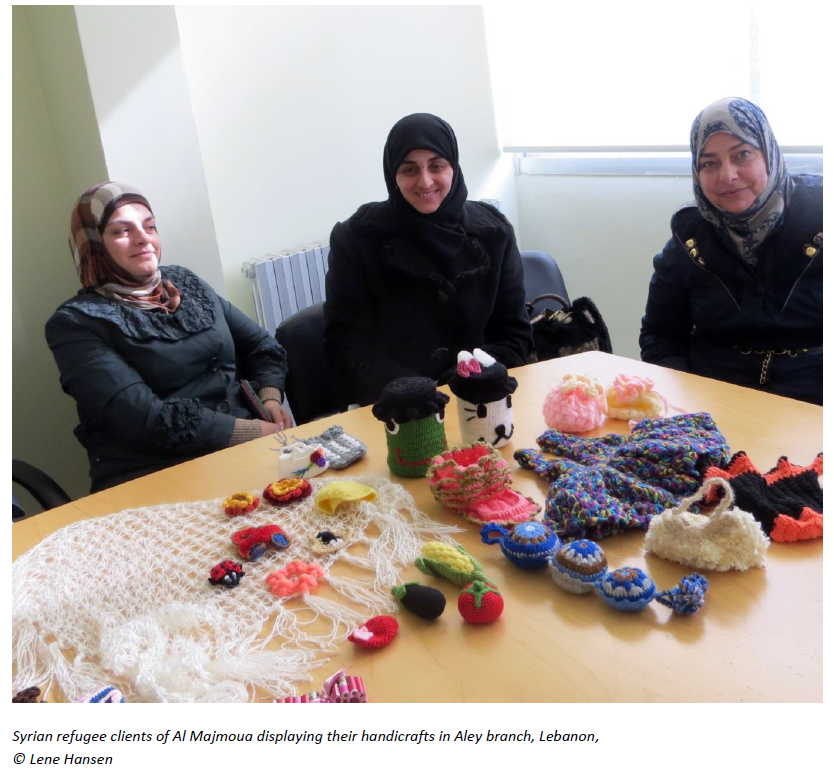 This post was first published as 'Why do refugees make for bad microfinance clients?'.
This post was first published as 'Why do refugees make for bad microfinance clients?'.
“Refugee microfinance” is too risky, right? After all, refugees are more likely to default on their loan because they don’t have ties to the local community or profit-generating enterprises. They are likely to rejected by existing clients as “competition” or simply as outsiders. Refugees’ lack of collateral and their unstable legal status give them little incentive to develop a long-term relationship with the financial service provider (FSP). Right?
Not necessarily. In fact, quite the opposite has been true for Al Majmoua, a Lebanese microfinance institution (MFI) serving Syrian, Pilipino, and Palestinian migrants and refugees (in addition to low-income Lebanese clients). A new publication by the Social Performance Task Force’s (SPTF), Serving Refugee Populations in Lebanon - Lessons Learned from a New Frontier,[1] demonstrates how Al Majmoua successfully incorporates refugees into its lending operations and non-financial services. Focused primarily on the subject of Syrian refugees, the case study details how Al Majmoua’s analyed refugee needs and the existing market opportunities before opening up to refugees, and the financial success of the model.
The Syrian refugee portion of Al Majmoua’s portfolio has a portfolio at risk (PAR30) of 0.85%, compared to the MFI’s overall PAR30 of 0.72%. An insignificant difference, to say the least. Overall, the MFI recorded 60 cases of flight (0.11% of the portfolio) in 2015—a number inconsistent with public perception of the risks associated with refugee microfinance. In interviews with loan officers, the SPTF found that Al Majmoua staff saw no difference in entrepreneurship potential, nor in the performance, group collapse rate, or repayment rate of mixed groups (groups composed of Lebanese and Syrian clients) compared to Lebanese-only groups.
This is not to say that refugees are easy to serve. They have unique needs and face greater barriers to entry into their host economy. However, Al Majmoua’s experience should be an encouragement to other FSPs and their funders. Here are a few of the key bits of wisdom gained from the MFI’s experience working with Syrians over the past few years:
1. Expect resistance by clients and staff. Al Majmoua staff were concerned that their portfolio quality would suffer. Angry clients perceived that Syrian immigrants were reducing the market-shares of Lebanese microentreprenuers. The MFI facilitated many open discussions—with the board, staff, clients, and refugees—about their concerns, stereotypes, and assumptions. This ongoing conversation has been an essential part of easing all parties into an inclusive business model.
2. Do the work upfront. Al Majmoua argues that an MFI doesn’t need a special product just for refugees—and in fact, such a delineation between refugees and “regular” clients is bad for business. Instead, the MFI engaged in detailed market research to get to know the refugee population: Where do they live? What are their income-generating activities? What barriers do they face that nationals do not? With this information, the MFI saw a clear way forward—loans made to groups with both Lebanese and Syrian women, combined with business training. The upfront investment to understand the needs of refugees, and the biases of staff and existing clients, allowed the MFI to determine who they could serve best, and how.
3. Non-financial services are a great entry point. Offering non-financial services can be a great entry point for refugees who are often socially isolated. Al Majmoua set up meeting centers where refugees and low-income national alike accessed all sorts of social, personal, and vocational trainings and support. More than anything else, these centers created trust between refugees and the financial institution, and helped integrate them into the broader community.
4. Consider product modifications. As mentioned previously, AL Majmoua found that relegating refugees to a separate product or program would have exacerbated tensions between refugees and Lebenese nationals. However, not all product terms will be appropriate for refugees. For example, finding national guarantors is harder for refugees, so an MFI might consider alternatives such as social vetting by (refugee) associations, places of worship, or relatives; evidence of stability like long-term rental contracts, children in school, spouse in formal job; and evidence of repayment capacity like remittance receipts, in place of of national guarantor.
What the Al Majmoua case show us is that when outreach is done right, refugees can make excellent clients for FSPs. In fact, refugees may be the next frontier for financial inclusion. However, there is much work to do to generate interest in and knowledge on how to serve refugees successfully. In 2016, the SPTF, in partnership with the Livelihoods Unit of the United Nations High Commissioner for Refugees (UNHCR) will produce Global Guidelines for FSPs Serving Refugees. Based on these guidelines, the SPTF will also offer training materials for FSPs and technical assistance providers who wish to learn best practice for providing financial services to refugees. Our hope is that with greater knowledge and proof of successful practice, increasing numbers of FSPs will be willing to extend their services to refugees.
What do you think? Are refugees too risky a market for financial service providers? Do you know of successful models for providing financial services to this target population?
Want to know more? Listen to the SPTFs introductory webinar: Refugees- The Next Frontier in Financial Inclusion? Also available: the presentation notes and PowerPoint. Sign up to receive notifications of upcoming SPTF events and publication releases or contact info@sptf.info.



Leave a comment